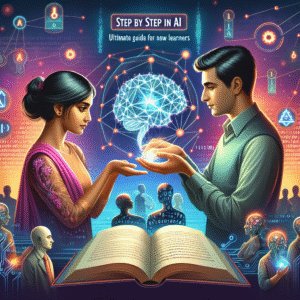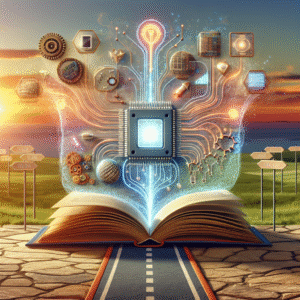Artificial Intelligence (AI) has become one of the most transformative technologies of our time. From self-driving cars to voice-activated assistants, AI is everywhere, revolutionizing the way we live and work. But what exactly is AI, and how does it function? In this article, we will explore the science and technology behind AI, uncovering the mechanisms that drive smart machines.
Understanding Artificial Intelligence
At its core, AI refers to the simulation of human intelligence processes by machines, especially computer systems. These processes include learning (acquiring information and rules for using it), reasoning (using rules to reach approximate or definite conclusions), and self-correction. AI can be classified broadly into two types: Narrow AI and General AI.
Narrow AI is specialized in a single task and is the most common form today. Examples include speech recognition systems like Siri or Alexa, and recommendation algorithms used by Netflix or Amazon. General AI, on the other hand, refers to systems that possess the ability to perform any intellectual task that a human can do. As of now, General AI remains largely theoretical and is a long-term goal in the field.
The Science Behind AI
The development of AI is rooted in multiple scientific disciplines, including computer science, mathematics, psychology, neuroscience, cognitive science, linguistics, operations research, economics, and more. Let’s delve into some of the core areas:
Machine Learning
Machine Learning (ML) is a subset of AI that focuses on the development of algorithms that enable computers to learn from and make decisions based on data. ML is classified into several types, such as supervised learning, unsupervised learning, semi-supervised learning, and reinforcement learning.
-
Supervised Learning: Involves training a model on a labeled dataset, which means that each training example is paired with an output label. The model learns to predict the label of new data. It’s widely used in applications like spam detection and image recognition.
-
Unsupervised Learning: Here, the model is provided with data that has no labels and it tries to find patterns or intrinsic structures in the input data. Clustering and association problems are typical examples.
- Reinforcement Learning: In this type, the model learns to make decisions by taking actions in an environment to achieve maximum cumulative reward. It’s commonly used in robotics and game playing, notable in systems that have beaten human champions in games like Go and chess.
Neural Networks
Inspired by the human brain, neural networks are a series of algorithms that mimic the way our brains operate to recognize patterns. They are composed of layers of interconnected nodes or "neurons." A simple neural network might have three layers: an input layer, a hidden layer, and an output layer. More complex networks, known as deep learning models, have many hidden layers, allowing them to handle vast amounts of data with complicated patterns.
Deep learning, a subfield of machine learning driven by these neural networks, has led to major advances in fields such as image and speech recognition. For example, convolutional neural networks (CNNs) are used extensively in analyzing visual imagery, while recurrent neural networks (RNNs) are suited for time-series data like handwriting or voice recognition.
Natural Language Processing
Natural Language Processing (NLP) is a field of AI that enables machines to read, understand, and derive meaning from human languages. It combines computational linguistics with machine learning and deep learning models to achieve this.
Applications of NLP include chatbots, sentiment analysis, language translation, and voice recognition systems. NLP models have attained remarkable levels of accuracy due to advancements in frameworks like transformers, which underpin models like OpenAI’s GPT and Google’s BERT.
The Technology Driving AI
AI technologies rely on powerful computational tools and algorithms. Here are some of the foundational technologies:
Big Data
Data is the lifeblood of AI. It allows models to learn patterns and make informed decisions. The proliferation of sensors, IoT devices, and the internet has led to an explosion of data available for AI to leverage. Big Data technologies help in storing, processing, and analyzing massive datasets that AI systems require to function effectively.
Cloud Computing
Cloud computing provides the computational power and storage capacity required to handle and process large-scale AI models. It allows for scalability, flexibility, and the efficient distribution of resources. Major cloud computing platforms like AWS, Microsoft Azure, and Google Cloud offer AI and ML services that provide infrastructure and pre-trained models to ease AI deployment.
High-Performance Computing
The complex computations required for training advanced AI models demand high-performance computing (HPC) capabilities. GPUs (Graphics Processing Units) and TPUs (Tensor Processing Units) are specialized hardware accelerators used to speed up the training process and perform large-scale simulations.
AI in Action
Artificial Intelligence applications span a wide range of domains. Here are some areas where AI is making significant impacts:
Healthcare
AI is transforming the healthcare industry by improving diagnostic accuracy, personalizing treatment, predicting patient outcomes, and streamlining operations. AI-driven tools can analyze medical images, predict diseases such as diabetes or cancer, and assist in drug discovery.
Autonomous Vehicles
Self-driving cars utilize AI to perceive the environment, make decisions, and navigate. Sensors, cameras, and radar systems collect data that the vehicle’s AI system processes to understand traffic conditions, recognize objects, and control the vehicle’s movements.
Finance
AI algorithms are used for high-frequency trading, fraud detection, credit risk assessments, and personalized banking services. By analyzing patterns and trends, AI systems can provide financial insights and predictions that enhance decision-making.
Retail
In retail, AI drives recommendation engines, predicts inventory needs, and optimizes supply chain processes. Virtual assistants and chatbots enhance customer experience by offering immediate assistance and personalized recommendations.
Entertainment
AI enriches the entertainment sector by powering recommendation systems, creating realistic video game environments, and enabling virtual reality experiences. AI models analyze user preferences to recommend movies, music, and other media content.
The Ethical Dimension
With AI’s growing influence, ethical considerations are increasingly crucial. Issues like data privacy, algorithmic bias, and accountability in AI decisions are hot topics. There is an ongoing need for frameworks and regulations to ensure AI systems are used responsibly and transparently.
Conclusion
The science and technology driving AI are vast and ever-evolving. As AI continues to advance, its potential to revolutionize various sectors becomes more apparent. Understanding the mechanisms behind AI helps us appreciate its capabilities and prepare for a future where intelligent machines become even more integrated into our daily lives.




